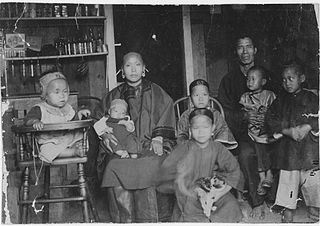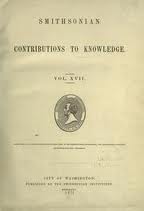An incest taboo is any cultural rule or norm that prohibits sexual relations between certain members of the same family, mainly between individuals related by blood. All human cultures have norms that exclude certain close relatives from those considered suitable or permissible sexual or marriage partners, making such relationships taboo. However, different norms exist among cultures as to which blood relations are permissible as sexual partners and which are not. Sexual relations between related persons which are subject to the taboo are called incestuous relationships.
Matrilineality is the tracing of kinship through the female line. It may also correlate with a social system in which each person is identified with their matriline, their mother's lineage, and which can involve the inheritance of property and titles. A matriline is a line of descent from a female ancestor to a descendant of either gender in which the individuals in all intervening generations are mothers. In a matrilineal descent system, an individual is considered to belong to the same descent group as their mother. This ancient matrilineal descent pattern is in contrast to the currently more popular pattern of patrilineal descent from which a family name is usually derived. The matriline of historical nobility was also called their enatic or uterine ancestry, corresponding to the patrilineal or "agnatic" ancestry.

In anthropology, kinship is the web of social relationships that form an important part of the lives of all humans in all societies, although its exact meanings even within this discipline are often debated. Anthropologist Robin Fox says that the study of kinship is the study of what humans do with these basic facts of life – mating, gestation, parenthood, socialization, siblingship etc. Human society is unique, he argues, in that we are "working with the same raw material as exists in the animal world, but [we] can conceptualize and categorize it to serve social ends." These social ends include the socialization of children and the formation of basic economic, political and religious groups.
Iroquois kinship is a kinship system named after the Haudenosaunee people, also known as the Iroquois, whose kinship system was the first one described to use this particular type of system. Identified by Lewis Henry Morgan in his 1871 work Systems of Consanguinity and Affinity of the Human Family, the Iroquois system is one of the six major kinship systems.
Eskimo kinship or Inuit kinship is a category of kinship used to define family organization in anthropology. Identified by Lewis Henry Morgan in his 1871 work Systems of Consanguinity and Affinity of the Human Family, the Eskimo system was one of six major kinship systems. The system of English-language kinship terms falls into the Eskimo type.
Hawaiian kinship, also referred to as the generational system, is a kinship terminology system used to define family within languages. Identified by Lewis H. Morgan in his 1871 work Systems of Consanguinity and Affinity of the Human Family, the Hawaiian system is one of the six major kinship systems.
Ambilineality is a form of kinship affiliation of cognatic descent that relies on self-defined affiliation within a given social system, meaning individuals have the choice to be affiliated with their mother's or father's group. Common features of societies that practice ambilineality are a shared set of land, communal responsibilities, and collective ownership of some segments of wealth and debt in their societies. This system of descent is distinct from more common genealogical structures in that rather than determining affiliation and descent using the standard determinants of biological and genealogical relation, it instead relies heavily on voluntary affiliation with one's group, oftentimes being determined by factors including residence.
Omaha kinship is the system of terms and relationships used to define family in Omaha tribal culture. Identified by Lewis Henry Morgan in his 1871 work Systems of Consanguinity and Affinity of the Human Family, the Omaha system is one of the six major kinship systems which he identified internationally.
Sudanese kinship, also referred to as the descriptive system, is a kinship system used to define family. Identified by Lewis Henry Morgan in his 1871 work Systems of Consanguinity and Affinity of the Human Family, the Sudanese system is one of the six major kinship systems.
In discussing consanguineal kinship in anthropology, a parallel cousin or ortho-cousin is a cousin from a parent's same-sex sibling, while a cross-cousin is from a parent's opposite-sex sibling. Thus, a parallel cousin is the child of the father's brother or of the mother's sister, while a cross-cousin is the child of the mother's brother or of the father's sister. Where there are unilineal descent groups in a society, one's parallel cousins on one or both sides will belong to one's own descent group, while cross-cousins will not.
Structural anthropology is a school of sociocultural anthropology based on Claude Lévi-Strauss' 1949 idea that immutable deep structures exist in all cultures, and consequently, that all cultural practices have homologous counterparts in other cultures, essentially that all cultures are equatable.

The Chinese kinship system is among the most complicated of all the world's kinship systems. It maintains a specific designation for almost every member's kin based on their generation, lineage, relative age, and gender. The traditional system was agnatic. based on patriarchal power, patrilocal residence, and descent through the male line. Although there has been much change in China over the last century, especially after 1949, there has also been substantial continuity.
The alliance theory, also known as the general theory of exchanges, is a structuralist method of studying kinship relations. It finds its origins in Claude Lévi-Strauss's Elementary Structures of Kinship (1949) and is in opposition to the functionalist theory of Radcliffe-Brown. Alliance theory has oriented most anthropological French works until the 1980s; its influences were felt in various fields, including psychoanalysis, philosophy and political philosophy.
Kinship terminology is the system used in languages to refer to the persons to whom an individual is related through kinship. Different societies classify kinship relations differently and therefore use different systems of kinship terminology; for example, some languages distinguish between consanguine and affinal uncles, whereas others have only one word to refer to both a father and his brothers. Kinship terminologies include the terms of address used in different languages or communities for different relatives and the terms of reference used to identify the relationship of these relatives to ego or to each other.

Family is a group of people related either by consanguinity or affinity. It forms the basis for social order. The purpose of the family is to maintain the well-being of its members and of society. Ideally, families offer predictability, structure, and safety as members mature and learn to participate in the community. Historically, most human societies use family as the primary locus of attachment, nurturance, and socialization.

Etruscan society is mainly known through the memorial and achievemental inscriptions on monuments of Etruscan civilization, especially tombs. This information emphasizes family data. Some contractual information is also available from various sources. The Roman and Greek historians had more to say of Etruscan government.
Irish kinship is a system of kinship terminology which shows a bifurcate collateral pattern. This system is used by a minority of people living in the Gaeltacht regions of Ireland. Irish kinship terminology varies from English kinship as it focuses on gender and generation, with less emphasis on differentiating lineal vs. collateral.

Systems of Consanguinity and Affinity of the Human Family is an 1871 book written by Lewis Henry Morgan and published by the Smithsonian Institution. It is considered foundational for the discipline of anthropology and particularly for the study of human kinship. It was the culmination of decades of research into the variety of kinship terminologies in the world conducted partly through fieldwork and partly through a global survey of kinship terminologies in the languages and cultures of the world.
Sesotho – the language of the Basotho ethnic group of South Africa and Lesotho – has a complex system of kinship terms which may be classified to fall under the Iroquois kinship pattern. The complex terminology rules are necessitated in part by the traditional promotion of certain forms of cousin marriage among the Bantu peoples of sub-Saharan Africa. Most of the terms used have common reconstructed Proto-Bantu roots.
Variations in the number of lexical categories across the languages is a notable idea in cultural anthropology. A former study on "color terms" explores such variations. Brent Berlin and Paul Kay (1969) argued that these qualitative and quantitative differences can be organized into a coherent hierarchy. As far as kinship terms are concerned, the variation is not found as an hierarchical organization, but as a result of conditions or constraints. That is to say, the number of kinship terms varies across the languages because of sociocultural conditions or constraints on the biological traits.






